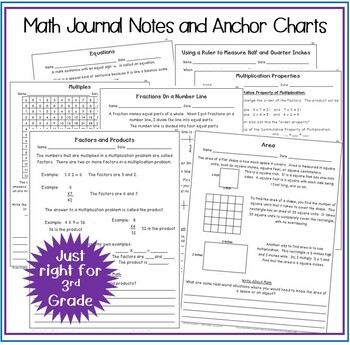Math Journal Notes and Anchor Charts
- PDF
What educators are saying
Description
Do your students' math journals need a little more structure? Do you want to start using student notebooks, or supplement the math journal resources you have?
These pages are the perfect starting point or supplement for your students' math notebooks. 60 pages of explanations and examples aligned with Core math standards can be quickly and easily added to a 3-ring binder or reduced in size and glued or taped into a smaller journal.
Each page can stand alone or can act as a mini anchor chart. Paste the anchor chart on the left hand side. On the right side, students can add their own notes, drawings, diagrams, or even a foldable. Enlarge the pages for display in the classroom, then students have the same anchor chart in their journals that is used in the classroom during lessons! Take a look at the preview for more information.
These pages provide comprehensive coverage of core 3rd grade standards, but also cover some 2nd and some 4th grade core standards.
The following topics are covered in Math Journal Notes:
Digits
Place Value
Place Value Models
Comparing Numbers
Standard and Expanded Form
Odd and Even Numbers
Rounding Numbers
Addends and Sums
Addition Properties
Addition Strategies
Equations
Addition with Regrouping
Problem Solving
Solving Two-Step Problems
Arithmetic Patterns
Arrays
Addition and Subtraction: Related Operations
Subtraction with Regrouping
Multiplication
Multiplication Properties
Order of Operations
Factors and Products
Multiples
Division
Metric Measurement—Centimeters, Meters, and Kilometers
Metric Measurement—Liters and Milliliters
Metric Measurement—Grams and Kilograms
Customary Measurement—Inches, Feet, Yards, and Miles
Using a Ruler to Measure Half and Quarter Inches
Customary Measurement—Pounds and Ounces
Customary Measurement—Cups, Pints, Quarts, and Gallons
Tally Charts and Frequency Tables
Graphs
Line Plots
Telling Time-The Clock Face
Telling Time
Periods of Time
Elapsed Time
Money
Geometry Vocabulary
Polygons
Quadrilaterals
Perimeter
Area
Understanding Fractions
Fractions
Comparing Fractions
Equivalent Fractions
Fractions on a Number Line
Fractions Equal to and Greater Than One
Want to be informed about new products, discounts, and freebies in my store? Find the green star near the top of this page. Click the "Follow Me" link and you'll receive emails about my store! All new products are 50% off for the first two days they are in my store, so become a follower to be notified of new products and take advantage of this great deal!





